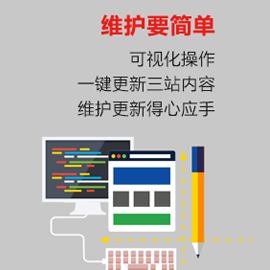MobileWeb開發(fā)基礎之四--處理手機設備的橫豎屏問題
為了應對移動設備屏幕的碎片化,我們在開發(fā)Mobile Web應用時,一個最佳實踐就是采用流式布局,保證最大可能地利用有限的屏幕空間。由于屏幕存在著方向性,用戶在切換了屏幕的方向后,有些設計上或實現(xiàn)上的問題就會凸顯——我們至少需要處理一下當前顯示元素的寬度的適配(當然,要做的可能不僅僅是這個)。很多時候,我們需要為不同的屏幕方向來設計對應的應用顯示模式,這個時候,實時地獲知設備的模豎屏狀態(tài)就顯得極為重要。

創(chuàng)新互聯(lián)建站專業(yè)為企業(yè)提供鎮(zhèn)遠網站建設、鎮(zhèn)遠做網站、鎮(zhèn)遠網站設計、鎮(zhèn)遠網站制作等企業(yè)網站建設、網頁設計與制作、鎮(zhèn)遠企業(yè)網站模板建站服務,十載鎮(zhèn)遠做網站經驗,不只是建網站,更提供有價值的思路和整體網絡服務。
- window.orientation屬性與onorientationchange事件
window.orientation :這個屬性給出了當前設備的屏幕方向,0表示豎屏,正負90表示橫屏(向左與向右)模式
onorientationchange : 在每次屏幕方向在橫豎屏間切換后,就會觸發(fā)這個window事件,用法與傳統(tǒng)的事件類似
1:使用onorientationchange事件的回調函數(shù),來動態(tài)地為body標簽添加一個叫orient的屬性,同時以body[orient=landspace]或body[orient=portrait]的方式在css中定義對應的樣式,這樣就可以實現(xiàn)在不同的屏幕模式下顯示不同的樣式。如下代碼示例:
<!Doctype html>
<html>
<head>
<meta charset="utf-8">
<meta id="viewport" name="viewport" content="width=device-width,initial-scale=1.0;">
<title>橫豎屏切換檢測</title>
<style type="text/css">
body[orient=landscape]{
background-color: #ff0000;
}
body[orient=portrait]{
background-color: #00ffff;
}
</style>
</head>
<body orient="landspace">
<div>
內容
</div>
<script type="text/javascript">
(function(){
if(window.orient==0){
document.body.setAttribute("orient","portrait");
}else{
document.body.setAttribute("orient","landscape");
}
})();
window.onorientationchange=function(){
var body=document.body;
var viewport=document.getElementById("viewport");
if(body.getAttribute("orient")=="landscape"){
body.setAttribute("orient","portrait");
}else{
body.setAttribute("orient","landscape");
}
};
</script>
</body>
</html>2: 類似的思路,不通過CSS的屬性選擇器來實現(xiàn),如下代碼的實現(xiàn)方案:
<!Doctype html>
<html>
<head>
<meta charset="utf-8">
<meta id="viewport" name="viewport" content="width=device-width,initial-scale=1.0;">
<title>橫豎屏切換檢測</title>
<style type="text/css">
.landscape body {
background-color: #ff0000;
}
.portrait body {
background-color: #00ffff;
}
</style>
</head>
<body orient="landspace">
<div>
內容
</div>
<script type="text/javascript">
(function(){
var init=function(){
var updateOrientation=function(){
var orientation=window.orientation;
switch(orientation){
case 90:
case -90:
orientation="landscape";
break;
default:
orientation="portrait";
break;
}
document.body.parentNode.setAttribute("class",orientation);
};
window.addEventListener("orientationchange",updateOrientation,false);
updateOrientation();
};
window.addEventListener("DOMContentLoaded",init,false);
})();
</script>
</body>
</html>
- 使用media query方式
這是一種更為方便的方式,使用純CSS就實現(xiàn)了對應的功能,如下代碼演示:
<!Doctype html>
<html>
<head>
<meta charset="utf-8">
<meta id="viewport" name="viewport" content="width=device-width,initial-scale=1.0;">
<title>橫豎屏切換檢測</title>
<style type="text/css">
@media all and (orientation : landscape) {
body {
background-color: #ff0000;
}
}
@media all and (orientation : portrait){
body {
background-color: #00ff00;
}
}
</style>
</head>
<body>
<div>
內容
</div>
</body>
</html>
- 低版本瀏覽器的平穩(wěn)降級
如果目標移動瀏覽器不支持media query,同時window.orientation也不存在,則我們需要采用另外一種方式來實現(xiàn)————使用定時器“偽實時”地對比當前窗口的高(window.innerHeight)與寬(window.innerWidth)之比,從而判定當前的橫豎屏狀態(tài)。如下代碼所示:
<!Doctype html>
<html>
<head>
<meta charset="utf-8">
<meta id="viewport" name="viewport" content="width=device-width,initial-scale=1.0;">
<title>按鍵</title>
<style type="text/css">
.landscape body {
background-color: #ff0000;
}
.portrait body {
background-color: #00ffff;
}
</style>
<script type="text/javascript">
(function(){
var updateOrientation=function(){
var orientation=(window.innerWidth > window.innerHeight)? "landscape" : "portrait";
document.body.parentNode.setAttribute("class",orientation);
};
var init=function(){
updateOrientation();
window.setInterval(updateOrientation,5000);
};
window.addEventListener("DOMContentLoaded",init,false);
})();
</script>
</head>
<body>
<div>
內容
</div>
</body>
</html>
- 統(tǒng)一解決方案
將以上的兩種解決方案整合在一起,就可以實現(xiàn)一個跨瀏覽器的解決方案,如下代碼:
<!Doctype html>
<html>
<head>
<meta charset="utf-8">
<meta id="viewport" name="viewport" content="width=device-width,initial-scale=1.0;">
<title>橫豎屏切換檢測</title>
<style type="text/css">
.landscape body {
background-color: #ff0000;
}
.portrait body {
background-color: #00ffff;
}
</style>
<script type="text/javascript">
(function(){
var supportOrientation=(typeof window.orientation == "number" && typeof window.onorientationchange == "object");
var updateOrientation=function(){
if(supportOrientation){
updateOrientation=function(){
var orientation=window.orientation;
switch(orientation){
case 90:
case -90:
orientation="landscape";
break;
default:
orientation="portrait";
}
document.body.parentNode.setAttribute("class",orientation);
};
}else{
updateOrientation=function(){
var orientation=(window.innerWidth > window.innerHeight)? "landscape":"portrait";
document.body.parentNode.setAttribute("class",orientation);
};
}
updateOrientation();
};
var init=function(){
updateOrientation();
if(supportOrientation){
window.addEventListener("orientationchange",updateOrientation,false);
}else{
window.setInterval(updateOrientation,5000);
}
};
window.addEventListener("DOMContentLoaded",init,false);
})();
</script>
</head>
<body>
<div>
內容
</div>
</body>
</html>
原英文網址:http://davidbcalhoun.com/2010/dealing-with-device-orientation
以上所述是小編給大家介紹的Mobile Web開發(fā)基礎之四--處理手機設備的橫豎屏問題,希望對大家有所幫助!
當前標題:MobileWeb開發(fā)基礎之四--處理手機設備的橫豎屏問題
網站鏈接:http://chinadenli.net/article40/gdgjeo.html
成都網站建設公司_創(chuàng)新互聯(lián),為您提供搜索引擎優(yōu)化、響應式網站、網站策劃、建站公司、Google、全網營銷推廣
聲明:本網站發(fā)布的內容(圖片、視頻和文字)以用戶投稿、用戶轉載內容為主,如果涉及侵權請盡快告知,我們將會在第一時間刪除。文章觀點不代表本網站立場,如需處理請聯(lián)系客服。電話:028-86922220;郵箱:631063699@qq.com。內容未經允許不得轉載,或轉載時需注明來源: 創(chuàng)新互聯(lián)

- 外貿建站要留意的各種因素 2022-10-28
- 深圳網站建設之外貿建站原則 2015-10-26
- 外貿建站之營銷型網站 2016-03-26
- 外貿建站需要多少錢 2015-05-02
- 外貿建站完成后如何繼續(xù)完善 2021-08-25
- 外貿建站選美國空間還是香港空間好? 2022-10-10
- 國內如何選擇專業(yè)外貿建站服務公司,創(chuàng)新互聯(lián)科技告訴你! 2015-05-01
- 越秀區(qū)小北路外貿建站,越秀區(qū)小北路外貿網站建設公司 2016-04-06
- 什么是外貿建站?建站前都有哪些必須了解的? 2015-08-19
- 外貿建站不得不說的秘密 2015-05-07
- 外貿建站推廣?八大技巧幫您引流 2016-03-01
- 外貿建站和推廣如何做 2021-01-28